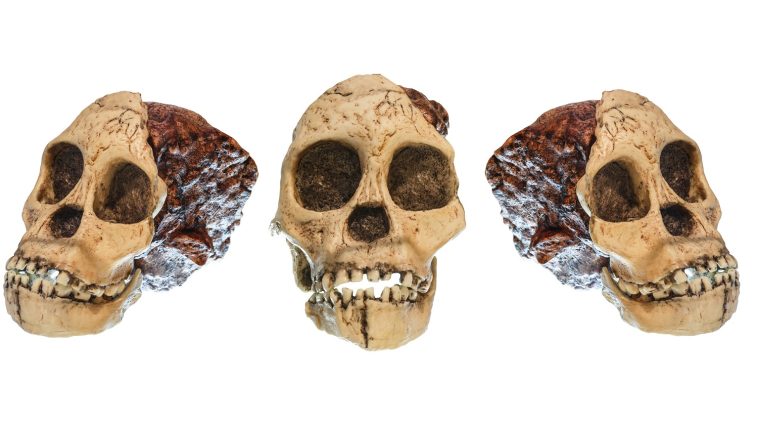[Originally published as Smithsonian Evolution Storytelling]
New high-resolution CT scans of the Taung Child skull by an international research team led by Ralph L. Holloway of Columbia University in New York cast renewed questions into the inane Smithsonian evolution storytelling practices of the institute.
Discovered in 1924 in South Africa, models of the skull have long since been duplicated for natural history museums as evidence for human evolution worldwide, including the Smithsonian. Found near Taung, South Africa, the lynchpin skull was tagged with the common name of Taung Child because of the fossil’s estimated age of 3 years, then later named Australopithecus africanus meaning the “southern ape from Africa.” Hollow’s new high-resolution CT scan images, however, undermine the long-held pre-Homo fossil status of the skull.
At the center of renewed contention is the skull’s absence of a front suture and fontanelle. While children of the age of 3 have a recognizable front suture, known as a metopic suture, Holloway could not detect any evidence of a metopic suture in the Taung skull.
These new CT scans are not the first to undermine the pre-Homo (ape-to-man) status of the skull. The Taung skull as a transitional human link is drawing an increasing line of critics. Until now, the Taung skull was the first and best example of early hominin (pre-Homo) brain evolution discovered in the fossil record. In the words of ScienceDaily, the Taung skull was once “South Africa’s premier hominin… the first and best example of early hominin brain evolution.” And, perhaps, one of the best examples of Smithsonian evolution storytelling yet.
Pre-Homo Critics
The transitional link status of the Taung skull was originally promoted in an article published in the journal Nature by anatomist and anthropologist Raymond Dart in 1925. However, in the following issue, Arthur Keith, Dart’s former mentor and one of the most prominent anatomists of his time, explained why the evidence failed to support the ape-to-man transitional status of the skull.
“The skull is that of a young anthropoid ape… there cannot be a moment’s hesitation in placing the fossil form in this living group,” Keith concluded.
Keith was joined by anatomical colleagues, including Grafton Elliot Smith and Arthur Smith Woodward. The skull, according to Elliot Smith was “essentially identical” to the skull of “the infant gorilla and chimpanzee” — not a pre-Homo species.
Solly Zuckerman (1904-1993), a student of Dart in South Africa, concluded in 1928 that the fossilized Taung skull was simply an ape. Later in the 1940s and 1950s, as a fellow of the Royal Society, Zuckerman used a “metrical and statistical approach,” a method thought to be more scientific than earlier purely descriptive methods to conclude that the Taung fossil had not walked on two legs and was not an intermediate form between humans and apes.
Pre-Homo Advocates
Robert Broom (1866-1951), a Scottish doctor who worked in South Africa, was one of Dart’s first — and for a long time one of his only — supporters.
By the end of the decade, though, American paleontologist William King Gregory (1876-1970) of the American Museum of Natural History in New York, agreed with Dart and Broom, claiming the skull was a pre-Homo transitional link between ape and man.
Gregory advocated Charles Darwin’s out-of-Africa model which was running in second place to the out-of-Asia model in evolutionary circles at the time. Since then, models of the skull have been placed in natural history museums worldwide as evidence of human evolution.
The Taung skull became a popular icon of evolution by the late twentieth century. A hologram of the skull was featured on the front cover of the November 1985 issue of National Geographic with the inscription “The search for early man.” The evolutionary ape-to-man story via natural selection was promoted as a scientific fact.
New evidence to underscore the pre-Homo status of the skull was published in 2012. At the School for Advanced Research in New Mexico, anthropologist Dean Falk used comparative fossil data to claim that “a clear metopic suture (MS) courses rostrally along the midline” was evidence supporting its pre-Homo status.
Using standard medical CT images, Falk demonstrated evidence to strengthen the transitional ape-to-man status of the skull in the paper “Metopic suture of Taung (Australopithecus africanus) and its implications for hominin brain evolution” published in the Proceedings of the National Academy of Science.
The original skull has remained at the University of Witwatersrand in Johannesburg. To date, no other similar skulls have been discovered.
High-Resolution CT Scan
Since the pre-Homo status of the Taung skull is contingent on the existence of the metopic suture, verifying the claims of Dart, Broom, Gregory, and Falk using modern technology is critical for maintaining the scientific credibility of the Smithsonian Institute.
Rather than using comparative fossil data produced by standard medical CT images, Holloway utilized a high-resolution CT (HRCT) scanner for the first time to evaluate the skull.
HRCT uses a narrower X-ray bean with advanced computer analysis allowing visualization of structures not possible with older CT scanning technologies.
Using HRCT, Holloway discovered that a “metopic suture is visible neither on the external table of the frontal bone nor on the rendering of the partial cranium.” In the paper “New high-resolution computed tomography data of the Taung partial cranium and endocast and their bearing on metopism and hominin brain evolution,” HRCT evidence for the suture was not found.
Holloway, along with research team members Douglas Broadfield of Florida Atlantic University and Kristian Carlson of the University of Witwatersrand, further reported: “The additional internal evidence of a metopic suture in the frontal of the Taung partial cranium is absent.”
The HRCT scan evidence undermines Falk’s 2012 “comparative fossil data” assessment of the metopic suture in 2012:
The form of metopic suture indicated in the high-resolution image data set of the Taung partial cranium is inconsistent with the form of metopic suture and open anterior fontanelle described by Falk and colleagues… Thus, neither of the predicted features necessary to support the form of metopic suture in the Taung Child suggested by Falk and colleagues are observed in the present study.
Contrary to expectations, the Taung skull did not demonstrate the same cranial skull characteristics found in modern human infants and toddlers. Senior researcher Kristian Carlson, in an interview with Times Live, conceded that “there is no sign of fusion.”
The evidence undermines the long-held pre-Homo status of the skull. In an article published in the John Hopkins News-Letter entitled “Taung child’s skull compared to human’s,” writer Elli Tian points to the glaring problem for human evolution:
The evolution of our species, and what makes us human, is much more complicated than we’ve assumed in the past.
Piltdown Man Déjà Vu
The Taung skull story is a déjà vu of the Piltdown man meltdown crafted by the British Museum of Natural History in the early twentieth century. Smithsonian evolution storytelling must stop and explain why the Taung Child is not scientific evidence for human evolution. The Smithsonian serves as an icon of government support for the progressive agenda and the evolution industry – not science.
Genesis
The scientific evidence overwhelmingly continues to undermine the biological theory of evolution while continuing to support the Genesis account of creation.







